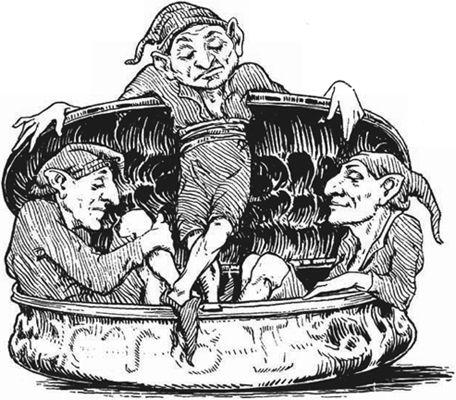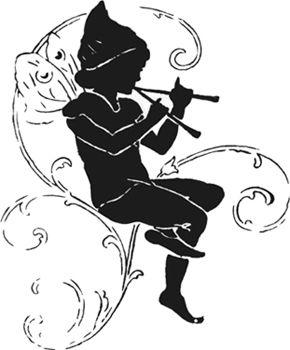Read The Sorcerer's Companion: A Guide to the Magical World of Harry Potter Online
Authors: Allan Zola Kronzek,Elizabeth Kronzek
The Sorcerer's Companion: A Guide to the Magical World of Harry Potter (28 page)
Because elves appear in the folklore of many nations, they come in all shapes and sizes. Most are said to resemble slender humans in their natural state, but they can change shape or vanish in the blink of an eye. An elf may be small enough to sleep under a toadstool or large enough to pass for human. The dark elves of Germany are said to be hideous, while Danish elves are renowned for their beauty. In English folklore, male elves are usually described as wizened old men, yet females are lovely, golden-haired maidens.
Elves of all nations specialize in using their supernatural powers to intervene in human lives. Although we’ve never heard of any quite like Dobby and his friends, who are bound to serve human masters and beat themselves up for disobedient behavior, many elves willingly devote themselves to helping out around the house. In the fairy tale “The Shoemaker and His Elves,” for example, two elves come to the aid of a poor, hungry shoemaker by fashioning beautiful shoes each night from the leather the cobbler lays out before going to bed. But when the shoemaker and his wife show their gratitude by leaving out a set of tiny new clothes for each elf, the elves squeal with delight, don their new outfits, and promptly depart, never to be seen again.

Why does the “gift” of a dirty old sock set Dobby free? While we don’t claim to know all the rules governing human–house elf relations, we do know that household fairies have always had a strong reaction to new clothes. Some, like the shoemaker’s elves, are overjoyed at the sight of fancy duds, while many others seem to find such gifts offensive. Either way, the result is the same: Leave out a new shirt or shoes for your elf, pixie, or brownie (see
boggart
), and you guarantee he’ll be gone by morning, never to return.
Explanations for this odd behavior vary from place to place. In some British folklore, household fairies are said to be free spirits who simply don’t want to be encumbered by earthly belongings. In the English county of Berwickshire, they say that brownies leave when given any gift because God appointed them as the servants of mankind, bound to work without payment. But in Lincolnshire the opposite is true; there brownies are proud creatures who will depart when gifts don’t measure up to their expectations. One story tells of a brownie who took to the road after receiving a shirt of coarse fabric, but not before making it known that he’d have stayed if the shirt were linen! Clearly, Dobby has no such reservations.
This may seem like a rude response to a kind gesture, but it’s mild compared to some of the tricks elves play. Indeed, it’s hard to find an elf (even a house elf) without a mischievous streak, and some are downright mean. In the folklore of Iceland and Germany, elves steal babies, rustle cattle, pilfer food, and cause diseases in humans and livestock. They also sit on people as they sleep, causing bad dreams (the German word for “nightmare” is
Alpdrücken
, or “elf pressure”), and enchant young men, sometimes holding them spellbound for years on end. The well-known American story of Rip Van Winkle, who sleeps for two decades, is based on this old folk belief.
In England, malicious elves were blamed for so many ills that a whole vocabulary developed to describe their evil deeds. During the Middle Ages, people or animals who died suddenly from mysterious ailments were said to have been “elf shot,” or struck by the arrow of an elf. Proof that such vicious attacks did occur was offered in the form of “elf arrows,” small flint arrowheads found in the countryside (which we now know were made by Stone Age men, not elves). People born with birth defects were said to be “elf marked,” and someone who suffered a paralyzing or deforming stroke was “elf twisted.” Even tangled hair was blamed on elves, who were said to turn smooth tresses into knotted “elf locks.”


 he
he
pixies
who run rampant in Gilderoy Lockhart’s classroom, the
leprechauns
who shower the Quidditch field with gold, and the house
elves
who labor in the Hogwarts kitchen all belong to a larger family known as fairies. Frequently referred to as the “little people,” the “wee folk,” the “good folk,” or the “good neighbors,” fairies make up a vast international community of immortal, supernatural beings who are only occasionally seen by humans. Although they are best known in their British forms, these magical creatures figure prominently in the folklore of countries throughout the world, from Sweden to Iran to China. Many of us are familiar with fairies from modern children’s stories, where they most often appear as tiny, good-humored people with generous hearts. In centuries past, however, fairy beliefs encompassed a great range of beings large and small, nasty and nice, frightening and funny, beautiful and ugly—from the murderous
red cap
of the Scottish borderlands to Cinderella’s kindly fairy godmother.

The word for “fairy” comes from the Latin
fata
, or fate, referring to the mythical Fates, three women who spin the threads of life, controlling each person’s destiny from birth to death. Like the fates, fairies were thought to be active participants in the lives of mortals, helping them out when they were so inclined but also delivering large doses of pain and misery. During the Middle Ages, fairies took the blame for a wide array of physical ailments, from skin rashes to tuberculosis. Bruises, cramps, and the pains of rheumatism were attributed to the pinching fingers of angry, invisible fairies. Those struck down by heart attacks, paralysis, or mysterious illnesses were said to have been “elf shot,” as if wounded by an invisible elf arrow. Mothers were warned to never leave their newborns out of sight, lest a fairy steal the infant and leave a sickly fairy baby, known as a changeling, in its place.
By the mid-sixteenth century, fear of fairies had been replaced by fear of
witches
, and fairies, while they could be mischievous pranksters like the
hinkypunk
, were more often thought of as benevolent and usually imaginary fun-loving creatures who were well disposed to humans. Fairy lore, which is vast and varied, tells of woodland kingdoms inhabited by tiny creatures clothed in exquisite fabrics of blue, green, and gold. Although they usually resemble the fairest of humans, fairies can shift shape to look like animals or become invisible at will. Great lovers of music, they dance round mushrooms and toadstools by the light of the moon, accompanied by tiny flutes and harps. Several old Scottish folk songs are said to be fairy tunes that were taught to mortal pipers lured into Fairyland by the beautiful melodies. Humans who are enticed to enter a fairy kingdom usually become lost in time, so that when they emerge, years have passed in the blink of an eye. But mortals who set out to search for Fairyland rarely find it, for legend has it that the realm of fairies is discovered only by chance.


